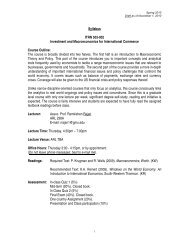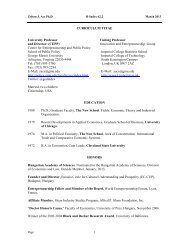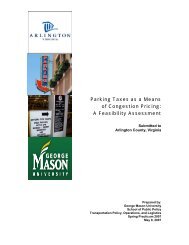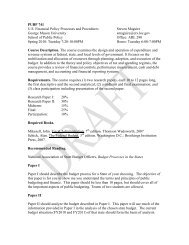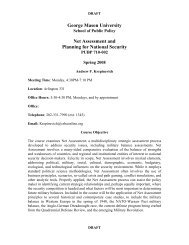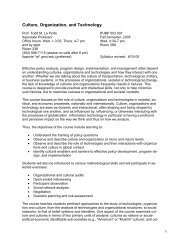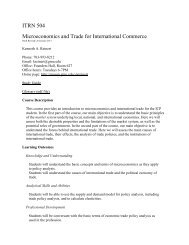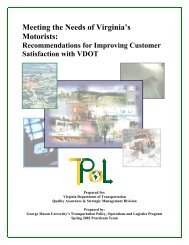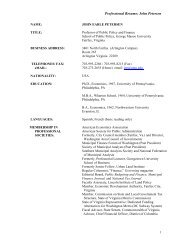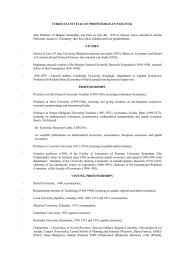Cost Benefit Analysis of Washington-Richmond High-Speed Rail
Cost Benefit Analysis of Washington-Richmond High-Speed Rail
Cost Benefit Analysis of Washington-Richmond High-Speed Rail
You also want an ePaper? Increase the reach of your titles
YUMPU automatically turns print PDFs into web optimized ePapers that Google loves.
<strong>Cost</strong> <strong>Benefit</strong> <strong>Analysis</strong> <strong>of</strong> <strong>Washington</strong>-<strong>Richmond</strong> <strong>High</strong>-<strong>Speed</strong> <strong>Rail</strong> Spring 2010<br />
4. What is a <strong>Cost</strong>-<strong>Benefit</strong> <strong>Analysis</strong>?<br />
A cost-benefit analysis is a term that typically refers to:<br />
24<br />
• Helping to appraise, or assess, the case for a project or proposal; and<br />
• An informal approach to making economic decisions <strong>of</strong> any kind. 16<br />
In a transportation context, a cost-benefit analysis attempts to measure the dollar value <strong>of</strong> the benefits<br />
and the costs to all the members <strong>of</strong> society where “society” is all residents <strong>of</strong> the United States on a net<br />
present value basis. The benefits represent a dollar measure to the extent the lives <strong>of</strong> people are made<br />
better by a project. The benefits represent the amount that all the people in society would jointly be<br />
willing to pay to carry out the project, and feel as if they had generated enough benefits to justify the<br />
project’s costs, accounting for the relative timing <strong>of</strong> those benefits and costs. In some cases, benefits<br />
may be difficult to measure monetarily. Therefore, when preparing a cost-benefit analysis, it is helpful<br />
to describe the nature <strong>of</strong> each major benefit. <strong>Benefit</strong>s should be quantifiable (e.g., in number <strong>of</strong> users<br />
making use <strong>of</strong> a transportation facility). Lastly, benefits should be measured in dollar terms, or<br />
monetized. This allows the benefits to be directly compared to the monetary costs <strong>of</strong> the project.<br />
<strong>Benefit</strong>s and costs must be estimated for each year <strong>of</strong> the project after work has begun. These annual<br />
benefits and costs must be discounted to the present using an appropriate discount rate so that a<br />
present value <strong>of</strong> the benefits and a present value <strong>of</strong> the costs is appropriately calculated and compared.<br />
The following provides a simplified example <strong>of</strong> discounted costs and benefits from a road project that<br />
provides travel time savings to local travelers over the course <strong>of</strong> five years following a one-year period<br />
<strong>of</strong> construction.<br />
16 “Dictionary.com,” in , 2010.



